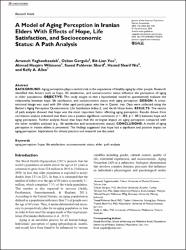A Model of Aging Perception in Iranian Elders With Effects of Hope, Life Satisfaction, and Socioeconomic Status: A Path Analysis

View/
Access
info:eu-repo/semantics/closedAccessDate
2018Author
Yaghoobzadeh, AmenehGorgulu, Ozkan
Yee, Bit-Lian
Wibisono, Ahmad Hasyim
Sharif, Saeed Pahlevan
Nia, Hamid Sharif
Allen, Kelly A.
Metadata
Show full item recordAbstract
BACKGROUND: Aging perception plays a central role in the experience of healthy aging by older people. Research identified that factors such as hope, life satisfaction, and socioeconomic status influence the perception of aging in older populations. OBJECTIVE: This study sought to test a hypothetical model to quantitatively evaluate the relationship between hope, life satisfaction, and socioeconomic status with aging perception. DESIGN: A cross-sectional design was used with 504 older aged participants who live in Qazvin, Iran. Data were collected using the Barker's Aging Perception Questionnaire, Life Satisfaction Index-Z, and Herth Hope Index. RESULTS: The results of path analysis showed that hope was the most important factor affecting aging perception. Results drawn from correlation analysis indicated that there was a positive significant correlation (r = .383, p < .001) between hope and aging perception. Further analysis found that hope had the strongest impact on aging perception compared with the other variables analyzed (e.g., life satisfaction and socioeconomic status). CONCLUSIONS: A model of aging perception in Iranian elders is presented. The findings suggested that hope had a significant and positive impact on aging perception. Implications for clinical practice and research are discussed.

















